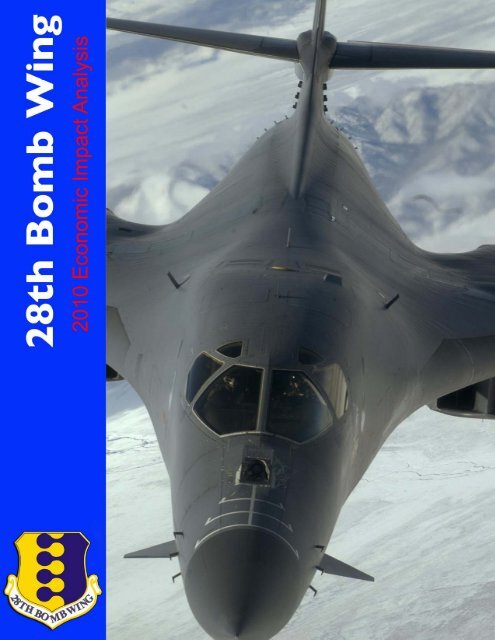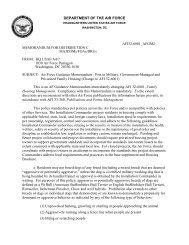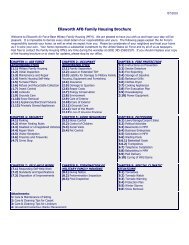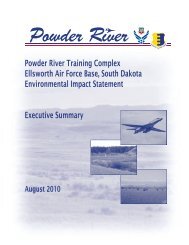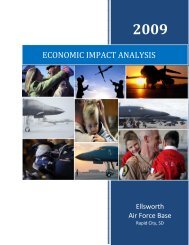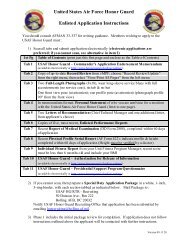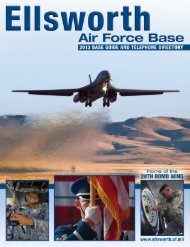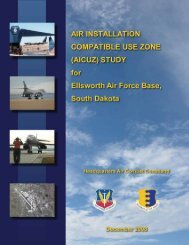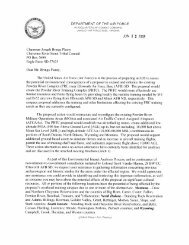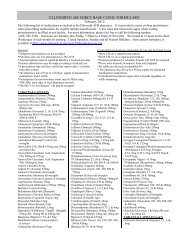Economic Impact - Ellsworth Air Force Base
Economic Impact - Ellsworth Air Force Base
Economic Impact - Ellsworth Air Force Base
- No tags were found...
Create successful ePaper yourself
Turn your PDF publications into a flip-book with our unique Google optimized e-Paper software.
2010 <strong>Economic</strong> <strong>Impact</strong> Analysis<br />
Outside Front Cover
Table of Contents<br />
PREFACE<br />
Commander’s Foreword<br />
ACC and 28th Bomb Wing Values and Mission<br />
i<br />
ii<br />
PART I<br />
Background<br />
PART II<br />
Wing Assets<br />
PART III<br />
Wing <strong>Economic</strong> <strong>Impact</strong><br />
PART IV<br />
Miscellaneous Information<br />
About the Analysis 2<br />
Availability of Information 2<br />
B‐1B Fact Sheet 3<br />
Current Value of Capital Assets and Sales 8<br />
Actual Retail Sales 8<br />
Personnel 10<br />
Annual Payroll 11<br />
Expenditures 12<br />
Estimate of Indirect Jobs Created 13<br />
Total <strong>Economic</strong> <strong>Impact</strong> Estimate 13<br />
<strong>Ellsworth</strong> Organizations 15
T<br />
he attached <strong>Economic</strong> <strong>Impact</strong> Analysis follows <strong>Air</strong> <strong>Force</strong><br />
standards to report <strong>Ellsworth</strong>’s impact to the surrounding<br />
local area. <strong>Ellsworth</strong> is the largest employer in the West River<br />
region, and the second‐largest in the state. In 2010, there were<br />
more than 1,100 local civilians working on base. However, this is<br />
only a small part of the contribution the <strong>Air</strong>men of <strong>Ellsworth</strong> make<br />
to the broader community.<br />
COMMANDER’S<br />
FOREWORD<br />
In our view, <strong>Ellsworth</strong> and the 28th Bomb Wing are not just next to<br />
a great community, we are part of a great community. Our over<br />
9,000 <strong>Air</strong>men and family members are dedicated to playing an<br />
active role in the welfare of the broader Black Hills – far beyond<br />
just jobs and payroll. In 2010, our <strong>Air</strong>men volunteered more than<br />
37,000 hours on and off base helping the local community. Some of<br />
their contributions include coaching children’s sports, working<br />
with Honor Flight, the Make‐a‐Wish Foundation and many other<br />
local charities.<br />
While active in the local community, the <strong>Air</strong>men of <strong>Ellsworth</strong> were<br />
even more engaged in combat operations overseas throughout<br />
2010. During this period, over 1,200 of our active duty <strong>Air</strong>men,<br />
roughly one third of the wing, were engaged in combat operations<br />
compiling an impressive 220,419 man‐days overseas. While flying<br />
3,400 hours at home, our <strong>Air</strong>men compiled an impressive 8,094<br />
combat hours overseas supporting over 340 troops‐in‐contact<br />
situations. This pattern is expected to continue for the foreseeable<br />
future.<br />
We are proud of all our <strong>Air</strong>men are doing for the nation both at<br />
home and overseas every day. But we are equally proud to be<br />
partners with the broader Black Hills community, and we look<br />
forward to continuing this special relationship.
<strong>Air</strong> Combat Command<br />
Values and Mission<br />
CORE VALUES<br />
MISSION<br />
Integrity First, Service Before Self, Excellence in All We Do<br />
The mission of <strong>Air</strong> Combat Command is to be the primary force provider<br />
of combat airpower to America’s warfighting commands. To<br />
support the global implementation of national security strategy, ACC<br />
operates fighter, bomber, reconnaissance, battle‐management, and<br />
electronic combat aircraft. It also provides command, control, communications<br />
and intelligence systems, and conducts global information<br />
operations.<br />
As a force provider, ACC organizes, trains, equips and maintains combat‐ready<br />
forces for rapid deployment and employment while ensuring<br />
strategic air defense forces are ready to meet the challenges of<br />
peacetime air sovereignty and wartime air defense. ACC numbered<br />
air forces provide the air component to U.S. Central, Southern, and<br />
Northern Commands, with Headquarters ACC serving as the air component<br />
to Joint <strong>Force</strong>s Command. ACC also augments forces to U.S.<br />
European, Pacific and Strategic Command.<br />
28th Bomb Wing<br />
Values and Mission<br />
CORE VALUES<br />
MISSION<br />
Integrity First, Service Before Self, Excellence in All We Do<br />
The mission of the 28th Bomb Wing is to put bombs on target.<br />
Every <strong>Air</strong>man in this Wing, whether it’s maintaining our people,<br />
equipment, pulling a trigger or aiming crosshairs, puts bombs on<br />
target.<br />
ii
Part I<br />
Background
About the Analysis<br />
METHODOLOGY<br />
The total economic impact of a base on its economic area is computed<br />
by summing annual base payroll, annual base expenditures,<br />
and the estimated dollar value of indirect jobs created. An economic<br />
area is generally defined as a Metropolitan Statistical Area<br />
(MSA). Each MSA has unique indirect job multipliers that are calculated<br />
by the Bureau of Labor Statistics (BLS) and are used to estimate<br />
the value of the indirect jobs created. The average annual pay<br />
for the local area was obtained from the U.S. Department of Labor<br />
Bureau of Labor Statistics. This analysis was prepared using a Secretary<br />
of the <strong>Air</strong> <strong>Force</strong> Directorate of <strong>Economic</strong> and Business Management<br />
(SAF/FMCE) program that was developed within the parameters<br />
of the Office of the Secretary of Defense’s <strong>Economic</strong> <strong>Impact</strong><br />
Analysis model. The economic impact takes into account both<br />
Appropriated Funds (APF) and Non‐Appropriated Funds (NAF).<br />
AVAILABILITY OF<br />
INFORMATION<br />
This <strong>Economic</strong> <strong>Impact</strong> Analysis (EIA) provides key information about<br />
the resources and economic impact <strong>Ellsworth</strong> AFB has on the surrounding<br />
communities. Release of this document to non‐military individuals<br />
must be approved by the Public Affairs Office at <strong>Ellsworth</strong><br />
AFB SD commercial (605) 385‐5057 or DSN 675‐5057. Questions<br />
concerning the content of this analysis should be directed to the Public<br />
Affairs Office.<br />
Information contained in this analysis is current as of 30 September<br />
2010. This analysis was prepared by 28 CPTS/FMA, Rita LaBelle at<br />
DSN 675‐1481 and <strong>Air</strong>man First Class Nikkolas Tessier at DSN 675‐<br />
5868 or commercial (605) 385‐1481 or 5868.<br />
2
B-1B Lancer<br />
Fact Sheet<br />
MISSION<br />
Carrying the largest payload of both guided and unguided weapons<br />
in the <strong>Air</strong> <strong>Force</strong> inventory, the multi‐mission B‐1B Lancer is the backbone<br />
of America's long‐range bomber force. It can rapidly deliver<br />
massive quantities of precision and non‐precision weapons against<br />
any adversary, anywhere in the world, at any time.<br />
FEATURES<br />
The B‐1's blended wing/body configuration, variable‐geometry<br />
wings and turbofan afterburning engines, combine to provide longrange,<br />
maneuverability and high speed while enhancing survivability.<br />
Forward wing settings are used for takeoff, landings, air refueling<br />
and in some high‐altitude weapons employment scenarios. Aft wing<br />
sweep settings ‐ the main combat configuration ‐‐ are typically used<br />
during high subsonic and supersonic flight, enhancing the B‐1's maneuverability<br />
in the low‐ and high‐altitude regimes. The B‐1's speed<br />
and superior handling characteristics allow it to seamlessly integrate<br />
in mixed force packages. These capabilities, when combined with its<br />
substantial payload, excellent radar targeting system, long loiter time<br />
and survivability, make the B‐1 a key element of any joint/composite<br />
strike force.<br />
The B‐1 is a highly versatile, multi‐mission weapon system. The B‐1's<br />
synthetic aperture radar is capable of tracking, targeting and engaging<br />
moving vehicles as well as self‐targeting and terrain‐following<br />
modes. In addition, an extremely accurate Global Positioning Systemaided<br />
Inertial Navigation System enables aircrews to navigate without<br />
the aid of ground‐based navigation aids as well as engage targets<br />
with a high level of precision. The Digital Communication Improvement<br />
radios provide a secure beyond line of sight reach back connectivity<br />
until Link‐16 is integrated on the aircraft. In a time sensitive<br />
targeting environment, the aircrew can use targeting data from the<br />
Combined <strong>Air</strong> Operations Center over Combat Track II, then to strike<br />
emerging targets rapidly and efficiently. This capability was effectively<br />
demonstrated during Operations Enduring Freedom and Iraqi<br />
Freedom.<br />
3
The B‐1's onboard self‐protection electronic jamming equipment,<br />
radar warning receiver (ALQ‐161) and expendable countermeasures<br />
(chaff and flare) system and a towed decoy system (ALE‐50) complements<br />
its low‐radar cross‐section to form an integrated, robust defense<br />
system that supports penetration of hostile airspace. The ALQ‐<br />
161 electronic countermeasures system detects and identifies the<br />
full spectrum of adversary threat emitters then applies the appropriate<br />
jamming technique either automatically or through operator inputs.<br />
Current modifications build on this foundation. Radar sustainability<br />
and capability upgrades will provide a more reliable system and may<br />
be upgraded in the future to include an ultra high‐resolution capability<br />
and automatic target recognition. The addition of a fully integrated<br />
data link, or FIDL, will add Link‐16 communications capability.<br />
FIDL combined with associated cockpit upgrades will provide the<br />
crew with a much more flexible, integrated cockpit, and will allow<br />
the B‐1 to operate in the fast‐paced integrated battlefield of the future.<br />
Several obsolete and hard to maintain electronic systems are<br />
also being replaced to improve aircraft reliability.<br />
4
The B‐1 was initially developed in the 1970s as a replacement for the B‐<br />
52. Four prototypes of this long‐range, high speed (Mach 2.2) strategic<br />
bomber were developed and tested in the mid‐1970s, but the program<br />
was canceled in 1977 before going into production. Flight testing continued<br />
through 1981.<br />
The B‐1 is an improved variant initiated by the Reagan administration in<br />
1981. Major changes included the addition of additional structure to increase<br />
payload by 74,000 pounds, an improved radar and reduction of<br />
the radar cross section by an order of magnitude. The inlet was extensively<br />
modified as part of this RCS reduction, necessitating a reduction in<br />
maximum speed to Mach 1.2.<br />
The first production B‐1 flew in October 1984, and the first B‐1 was delivered<br />
to Dyess <strong>Air</strong> <strong>Force</strong> <strong>Base</strong>, Texas, in June 1985. Initial operational<br />
capability was achieved on Oct. 1, 1986. The final B‐1 was delivered May<br />
2, 1988.<br />
The B‐1 holds almost 50 world records for speed, payload, range, and<br />
time of climb in its class. The National Aeronautic Association recognized<br />
the B‐1 for completing one of the 10 most memorable record flights for<br />
1994. The most recent records were made official in 2004.<br />
The B‐1 was first used in combat in support of operations against Iraq<br />
during Operation Desert Fox in December 1998. In 1999, six B‐1s were<br />
used in Operation Allied <strong>Force</strong>, delivering more than 20 percent of the<br />
total ordnance while flying less than 2 percent of the combat sorties.<br />
During the first six months of Operation Enduring Freedom, eight B‐1s<br />
dropped nearly 40 percent of the total tonnage delivered by coalition air<br />
forces. This included nearly 3,900 JDAMs, or 67 percent of the total. In<br />
Operation Iraqi Freedom, the aircraft has flown less 1 percent of the<br />
combat missions while delivering 43 percent of the JDAMs used. The B‐1<br />
continues to be deployed today, flying missions daily in support of continuing<br />
operations.<br />
Most recently, B-1B Lancers from the 28th Bomb Wing launched from their<br />
home station of <strong>Ellsworth</strong> <strong>Air</strong> <strong>Force</strong> <strong>Base</strong> to strike targets in Libya in support<br />
of Operation Odyssey Dawn. With less than two days from first notice to<br />
takeoff, <strong>Ellsworth</strong> <strong>Air</strong>men generated several aircraft and hundreds of weapons<br />
to provide the combat configuration needed halfway across the globe.<br />
This mission marked the first time the B-1 fleet has launched combat sorties<br />
from the continental United States to strike targets overseas.<br />
BACKGROUND<br />
5
GENERAL<br />
CHARACTERISTICS<br />
6<br />
POINT OF<br />
CONTACT<br />
Primary Function: Long-range, multi-role heavy bomber<br />
Contractor: Boeing, North America (formerly Rockwell<br />
International, North American <strong>Air</strong>craft); Offensive avionics,<br />
Boeing Military <strong>Air</strong>plane; Defensive avionics, EDO Corporation<br />
Power Plant: Four General Electric F101-GE-102 turbofan engine<br />
with afterburner<br />
Thrust: 30,000-plus pounds with afterburner, per engine<br />
Wingspan: 137 feet (41.8 meters) extended forward, 79 feet (24.1<br />
meters) swept aft<br />
Length: 146 feet (44.5 meters)<br />
Height: 34 feet (10.4 meters)<br />
Weight: approximately 90,000 pounds (86,183 kilograms)<br />
Maximum Takeoff Weight: 477,000 pounds (216,634 kilograms)<br />
Fuel Capacity: 265,274 pounds (120, 326 kilograms)<br />
Payload: 75,000 pounds (34,019 kilograms)<br />
Speed: 900-plus mph (Mach 1.2 at sea level)<br />
Range: Intercontinental<br />
Ceiling: More than 30,000 feet (9,144 meters)<br />
Armament: 24 GBU-31 GPS-aided JDAM (both Mk-84 general<br />
purpose bombs and BLU-109 penetrating bombs) or 24 Mk-84<br />
2,000-pound general purpose bombs; 8 Mk-85 naval mines; 84<br />
Mk-82 500-pound general purpose bombs; 84 Mk-62 500-<br />
pound naval mines; 30 CBU-87, -89, -97 cluster munitions; 30<br />
CBU-103/104/105 WCMD, 24 AGM-158 JASSMs or 12 AGM-<br />
154 JSOWs<br />
Crew: Four (aircraft commander, copilot and two weapon systems<br />
officers<br />
Unit Cost: $283.1 million (fiscal 98 constant dollars)<br />
Initial Operating Capability: October 1986<br />
Inventory: Active force, 64 (test, 2); ANG, 0; Reserve, 0<br />
<strong>Air</strong> Combat Command, Public Affairs Office; 115 Thompson<br />
Street, Suite 211; Langley AFB, VA 23665-1987<br />
DSN 574-5014 or (757) 764-5014<br />
e-mail: acc.pai@langley.af.mil
Part II<br />
Wing Assets
Current Value of Capital Assets and Sales<br />
As of 30 September 2010<br />
CURRENT VALUE OF CAPITAL ASSETS<br />
WEAPONS SYSTEMS<br />
B‐1 Bombers $ 7,926,800,000<br />
INVENTORIES (Sales outlets)<br />
Commissary $<br />
127,472<br />
Army and <strong>Air</strong> <strong>Force</strong> Exchange Service $ 3,000,000<br />
Non‐Appropriated Fund Activities $<br />
68,845<br />
TOTAL: $ 3,196,317<br />
CAPITAL ASSETS<br />
Runway 94,001,790<br />
Real Property On‐base $ 528,666,003<br />
Real Property Off‐base 13,018,750<br />
Military Family Housing $ 20,474,291<br />
Leased Housing $ 78,272,580<br />
On/Off‐base land $<br />
949,376<br />
TOTAL: $ 735,382,790<br />
TOTAL<br />
TOTAL: $ 8,665,379,107<br />
TOTAL VALUE OF ASSETS<br />
ACTUAL RETAIL SALES<br />
SALES OUTLET<br />
Commissary $ 14,496,387<br />
Army and <strong>Air</strong> <strong>Force</strong> Exchange Service $ 12,604,643<br />
Non‐Appropriated Fund Activities $<br />
887,988<br />
TOTAL: $ 27,989,018<br />
ACTIVITY REVENUE (Fees and Charges)<br />
Non‐Appropriated Fund Activities $ 3,634,192<br />
TOTAL REVENUES<br />
TOTAL: $ 31,623,210<br />
8
Part III<br />
Wing <strong>Economic</strong> <strong>Impact</strong>
Table 1<br />
Personnel by Classification and Housing Location<br />
LIVING LIVING<br />
CLASSIFICATION ON BASE OFF BASE TOTAL<br />
1. APPROPRIATED FUND MILITARY<br />
Active‐Duty Military 1,475 2,131 3,606<br />
<strong>Air</strong> <strong>Force</strong> Reserve/<strong>Air</strong> National Guard 3 0 3<br />
Non‐Extended Active Duty Reserve/<strong>Air</strong> Nat'l Guard 0 0 0<br />
Trainees/Cadets N/A N/A 0<br />
TOTAL: 1,478 2,131 3,609<br />
2. ACTIVE DUTY MILITARY DEPENDENTS<br />
4,468<br />
TOTAL: 4,468<br />
3. APPROPRIATED FUND CIVILIANS<br />
General Schedule 459<br />
Federal Wage Board 117<br />
Other * 52<br />
TOTAL: 628<br />
4. NON‐APPROPRIATED FUND CONTRACT CIVILIANS AND PRIVATE BUSINESS<br />
Civilian Non‐Appropriated Funds (NAF) 198<br />
Civilian <strong>Base</strong> Exchange (BX) 82<br />
Contract Civilians 267<br />
Private Businesses On <strong>Base</strong>, By Type:<br />
Branch Banks/Credit Union 30<br />
Other Civilians (not included elsewhere) 35<br />
TOTAL: 612<br />
TOTAL PERSONNEL: 9,317<br />
10<br />
* Defense Commissary Agency (DECA) employee wages
Table 2<br />
Annual Payroll by Classification and Housing Location<br />
LIVING LIVING<br />
CLASSIFICATION ON BASE OFF BASE TOTAL<br />
1. APPROPRIATED FUND MILITARY<br />
Active‐Duty Military $ 38,636,816 $ 90,544,960 $ 129,181,776<br />
<strong>Air</strong> <strong>Force</strong> Reserve/<strong>Air</strong> National Guard $ 191,100 $ ‐ $ 191,100<br />
Non‐Extended Active Duty Reserve/<strong>Air</strong> Nat'l Guard N/A N/A $<br />
‐<br />
Trainees/Cadets N/A N/A $<br />
‐<br />
TOTAL: $ 38,827,916 $ 90,544,960 $ 129,372,876<br />
2. APPROPRIATED FUND CIVILIANS<br />
General Schedule $ 28,262,397<br />
Federal Wage Board $ 6,998,318<br />
Other * $ 1,871,402<br />
TOTAL: $ 37,132,117<br />
3. NON‐APPROPRIATED FUND CONTRACT CIVILIANS AND PRIVATE BUSINESS EMPLOYEES<br />
Civilian Non‐Appropriated Fund (NAF) $ 3,212,381<br />
Civilian <strong>Base</strong> Exchange (BX) $ 1,814,266<br />
Contract Civilians $ 11,372,274<br />
Private Businesses On <strong>Base</strong>, By Type:<br />
Credit Union $ 576,605<br />
Other Civilians (not included elsewhere) $ 586,752<br />
TOTAL: $ 17,562,278<br />
TOTAL ANNUAL PAYROLL: $ 184,067,271<br />
11<br />
* Defense Commissary Agency (DECA) employee wages
CLASSIFICATION<br />
1. CONSTRUCTION<br />
Table 3<br />
Expenditures for Construction, Services and Procurement of<br />
Materials, Equipment and Supplies<br />
ACTUAL ANNUAL<br />
EXPENDITURES<br />
Military Construction Program $ 15,140,000<br />
Non‐Appropriated Fund $ 213,000<br />
Military Family Housing $ 664,000<br />
O&M (ARRA) $ 8,720,000<br />
Clinic (ARRA) $ 2,730,000<br />
TOTAL: $ 27,467,000<br />
2. SERVICES<br />
Services Contracts * $ 4,866,430<br />
Other Services (not included elsewhere) $ 229,276<br />
TOTAL: $ 5,095,706<br />
3. MATERIAL, EQUIPMENT, AND SUPPLY PROCUREMENT<br />
Commissary $<br />
86,650<br />
<strong>Base</strong> Exchange (BX) $ 4,808,988<br />
Health (TRICARE, Government cost only) $ 26,580,000<br />
Education (<strong>Impact</strong> aid and tuition assistance)** $ 8,054,554<br />
TDY $ 2,140,837<br />
AFFSC $ 1,394,030<br />
Other Materials, Equipment & Supplies (not included elsewhere) $ 19,076,492<br />
TOTAL: $ 62,141,551<br />
TOTAL ANNUAL EXPENDITURES: $ 94,704,257<br />
* Includes only contracts in the local economic area or contracts requiring the use<br />
of locally supplied goods and services.<br />
** Includes monies owed from previous year from Dept of Education<br />
12
Table 4<br />
Estimate of Indirect Jobs Created<br />
TOTAL<br />
TOTAL<br />
TYPE OF PERSONNEL BASE JOBS Multiplier INDIRECT JOBS<br />
Active‐Duty Military 3,606 0.29 1,046<br />
Reserve/<strong>Air</strong> National Guard/Trainees 3 0.13 ‐<br />
Appropriated Fund Civilians 628 0.43 270<br />
Other Civilians 612 0.43 263<br />
TOTAL: 4,849 1,579<br />
ESTIMATED NUMBER OF INDIRECT JOBS CREATED: 1,579<br />
LOCAL COMMUNITY AVG ANNUAL PAY: $ 33,306<br />
ESTIMATED ANNUAL DOLLAR VALUE OF JOBS CREATED: $ 52,590,174<br />
Table 5<br />
Total <strong>Economic</strong> <strong>Impact</strong> Estimate<br />
PERSONNEL COSTS<br />
Military $ 129,372,876<br />
Federal Civilian $ 37,132,117<br />
Other Civilian $ 17,562,278<br />
TOTAL ANNUAL PAYROLL: $ 184,067,271<br />
ANNUAL DIRECT EXPENDITURES<br />
TOTAL ANNUAL EXPENDITURES: $ 94,704,257<br />
ESTIMATED ANNUAL DOLLAR VALUE OF JOBS CREATED<br />
Estimated Indirect Jobs Created 1,579<br />
Average Annual Pay $<br />
33,306<br />
TOTAL VALUE OF JOBS CREATED: $ 52,590,174<br />
TOTAL ANNUAL ECONOMIC IMPACT ESTIMATE<br />
GRAND TOTAL: $ 331,361,702<br />
13
Part IV<br />
Miscellaneous Information
<strong>Ellsworth</strong> Organizations<br />
15<br />
HOST UNIT: 28th Bomb Wing<br />
28th Bomb Wing<br />
Associate Units<br />
Commander/Vice Commander<br />
Area Defense Council<br />
Command Chief<br />
Army‐<strong>Air</strong> <strong>Force</strong> Exchange Service<br />
Anti‐Terrorism Office<br />
<strong>Air</strong> <strong>Force</strong> Audit Agency<br />
AFSO 21<br />
<strong>Air</strong> <strong>Force</strong> Financial Services Center<br />
Chaplain<br />
<strong>Air</strong> <strong>Force</strong> Junior ROTC<br />
Command Post<br />
American Red Cross<br />
28th Comptroller Squadron<br />
<strong>Air</strong>man Leadership School<br />
Equal Opportunity<br />
Defense Commissary Agency<br />
Historian<br />
Defense Investigative Service<br />
Inspector General<br />
Defense Reutilization and Marketing Office<br />
Information Protection<br />
Detachment 8, 372d Training Squadron<br />
Judge Advocate<br />
Detachment 226, AFOSI<br />
Museum<br />
USAF Judiciary 4th Circuit<br />
Plans and Programs<br />
Belle Fourche Electronic Scoring Site<br />
Protocol (Lockheed‐Martin)<br />
Public Affairs<br />
Raytheon Support Service Company<br />
Treaty Compliance Office<br />
Sexual Assault Reponse Coordinator<br />
Wing Safety Office<br />
28th Operations Group<br />
34th Bomb Squadron<br />
37th Bomb Squadron<br />
28th Operations Support Squadron<br />
Detachment 1 (becomes 432 ATKS in 2012)<br />
28th Maintenance Group<br />
28th <strong>Air</strong>craft Maintenance Squadron<br />
28th Maintenance Squadron<br />
28th Maintenance Operations Squadron<br />
28th Munitions Squadron<br />
28th Mission Support Group<br />
28th Civil Engineer Squadron<br />
28th Communications Squadron<br />
28th Contracting Squadron<br />
28th <strong>Force</strong> Support Squadron<br />
28th Logistics Readiness Squadron<br />
28th Security <strong>Force</strong>s Squadron<br />
28th Medical Group<br />
28th Medical Operations Squadron<br />
28th Medical Support Squadron
Back Cover


